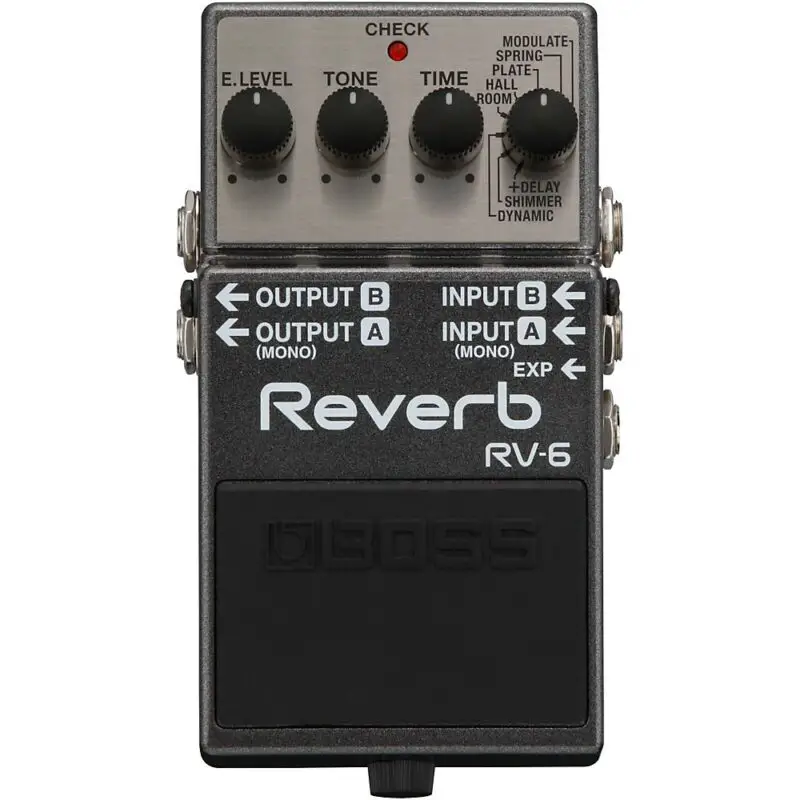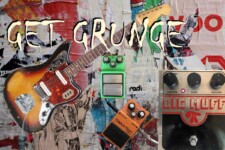Best Guitar Amp & Pedal Combos: Get Jangly Indie Rock Tone
Spearheaded by indie giants of the 80s like The Smiths and Echo & the Bunnymen, bands have taken inspiration from their jangle pop guitar tones ever since.
For a sound so defined by its bright and playful tone, working out what type of guitars, amps, and even pedals will create this iconic indie rock sound can be difficult information to find.
So today we’re going to be doing just that; uncovering what makes the indie rock tone so indie. We’ll be talking about specific gear and effects settings that will help you dial in your sound and capture the perfect tone for your next indie cult classic hit.

We work with various affiliate programs. If you purchase via our links we may earn a small commission at no extra cost to you.
Which Guitars Best Define Indie Rock?
Indie rock has been synonymous with stylish and unique looking guitars since the genre formed its root in the early 80s. From Johnny Marr sporting a 12 string Rickenbacker to the more recent example of St. Vincent designing her own custom signature Ernie Ball. Some might say a rule of thumb for indie rock is ‘if a guitar looks cool on stage then it’s good enough to play indie rock.
A lot of indie rock bands tend to Fender guitars, most commonly Stratocasters, Telecasters and guitars in the Jazzmaster family, including Jaguars and Mustangs.
If you’re trying to capture the doleful tones of jangle pop you don’t really want to be playing anything with active pickups or guitars designed to play metal.
Another type of guitar that is popular amongst indie rock musicians are semi-hollow electric guitars. These guitars take some of the acoustic elements of an acoustic guitar and apply them to an electric setup. The semi-hollow body creates a warmer more acoustic tone that makes chords and melodies sound natural and packed full of character.
The main things you want out of an indie rock guitar are that it’s capable of creating a good tone out of lighter gauge strings and has a good treble pick up to deliver those crisp jangly tones.
Solid Body Electrics
12 String Rickenbacker
To start us off the 12 string Rickenbacker is a staple of the indie rock world. What gives this guitar its unique sound is its 12 strings that give the guitar its jangly iconic sound. Heaps of indie rock guitarists have played them and a notable example is Johnny Marr of The Smiths; a band many credit for creating the indie rock sound still popular to this day.

Having 12 strings doesn’t mean you have 12 different strings but instead have the same 6 strings a standard guitar has, only each string is doubled. This creates all kinds of wonderful sound resonance that gives playing melodies and chords a bouncy and full tone.
Fender Stratocaster
No list of popular indie rock guitars would be complete without mentioning the Fender Stratocaster. Its famed versatility is what has made it so popular amongst bands, particularly those looking to create surfy indie rock tones.
While it might sound like an obvious choice to put a Stratocaster on this list it’s for very good reason. The Stratocaster isn’t known for dominating any one genre and that’s why indie musicians are attracted to it. Indie rock is all about being able to try out a variety of playing styles to find one that is unique. The Stratocaster is the go-to guitar for that.
Stratocasters are also known for their twangy ‘quack’ sound. This is great quality for a guitar if breezy indie tones are what you’re searching for. Both Doug Martsch from Built to Spill and Stephen Malkmus from Pavement played Stratocasters throughout their entire careers with these quinquennial indie bands.
Danelectro
Danelectro guitars rose to popularity within the psychedelic rock scene of the 60s but fell into obscurity until recently. Their wacky designs are always eye catching on stage and their heritage adds almost as much indie cred to the guitar as its tone does.
Danelectro guitars have a very unique sound that really can’t be compared to their counterparts. It has an instantly recognizable illuminating and joyful tone to it perfect for jangly rock. This is thanks mainly to its lipstick pickups and Nasonite body that no other guitars use.
If you like to go to gigs you might have spotted a stylish guitarist rocking one of these guitars but there are some notable indie musicians such as Zachary Cole Smith from DIIV that swear by them.
Semi Hollow Electrics
Gibson ES-355
Semi Hollow Electrics are another popular choice for indie rock guitarists. What makes them popular is their chirpier mid-range which is especially present on the Gibson ES-355. Being semi hollow means the guitar has a slightly more acoustic sound as well.
The Gibson ES-355 is a guitar best suited to a rhythm guitarist. Its naturally bouncy sound lends itself well to the typically upbeat chord patterns of indie rock rhythm.

Some guitarists known for their jangly sound including Graham Coxon from Blur and Brian Bell from Weezer have both played a Gibson ES-355 at some point in their career to bring a more acoustic vibe to an otherwise all solid body lineup of guitars.
The shallow hollowbody provokes just the right amount of malleable, almost three-dimensional, feedback
Good Amp Choices for Indie Rock Sound
Roland Jazz Chorus 120 Amp
The Roland Jazz Chorus or JC-120 has been the industry standard indie rock amp for decades now and it’s easy to see why once you’ve heard one. While not a tube amp it is nearly impossible to tell as it delivers some of the cleanest highs and mids of any amp your money can buy.

The amp has been used by everyone from indie rock royalty such as The Smiths and The Cure, to more recent bands such as Tame Impala and Mac Demarco.
What makes this amp a great choice for a guitarist chasing a jangling tone is its inbuilt bright switch that focuses the entire energy of the amp on the high ends of your playing. This single switch can turn a muddy melody into a shimmering string of notes.
Not only that but the amp has an inbuilt chorus that was so popular it led Roland to create a standalone guitar pedal that replicated the effect. This was actually the first guitar pedal Roland (under the name Boss) ever made.
Now combine the bright switch with the chorus and your set for perfect indie rock tones.


Here’s a sound byte of that exact combo in action!
Fender Hot Rod DeVille 212 Amp
Fender has two amps in their Hot Rod series (DeVille 212 and Deluxe) but only one of them is an undisputed indie rock essential.
The Fender Hot Rod DeVille 212 unlike its counterpart is all about delivering clean and bright tones perfectly suited to indie rock. The amp doesn’t lack in power either with a double channel 60 watt output that maintains the clarity of your tone even when you crank it.

The added bonus of the Deville‘s pre-amp input allows you to use the amp with an effects loop. This is a massive benefit when playing indie rock as it makes chaining pedals effects easy and it sounds better than running your pedals into the main input. This can often make your tone sound muddy and undefined.
This amp is an industry standard for indie rock guitarists with bands like Unknown Mortal Orchestra, Car Seat Headrest, and The Strokes guitarist swearing by them. Kim Gordon of Sonic Youth also says that every time she gigs she asks for DeVille amps and that they often end up getting Fender Twins, which she says “I don’t know why people like them so much”.
How to Set Your Guitar and Amp for Indie Rock Tones
Capturing the jangly sound of indie is all about bringing out the warmth of your highs and mids. In order to achieve this, you want to set your guitar to either your treble pickup or a combo of treble and mid pickups, (depending on what your guitar has).
This will help create the shimmery tone your after. Excessive low end is great for some genres but in this case, it’ll make your guitar sound too heavy for indie rock.
What Pedals & Combos Work Well For Indie Rock?
Effects pedals can take your indie tone to a new level if you know what you’re looking for. Some would even say they are essential.
- Using a light reverb with a short decay time will help make your tone dreamy and add ambiance to your sound.
- If you want to create a slacker type sound that’s laid back and grooves, then throwing a chorus pedal into your effects chain is essential. A great example of chorus helping to define a sound are the early Mac Demarco albums that are smeared in chorus throughout.
- While you don’t want to crank it having a little extra gain will do you no harm. A simple overdrive will help push your guitar over into a punchier sound without sounding like Metallica. You only want to turn it up a little bit and focus on increasing the tone knob more than the distortion knob.
When ordering your pedal make sure you always put your delays and reverbs last! These effects act as a trail to your sound and will make your tone sound bloated if placed early in your effects chain. On the other hand, distortions and overdrives should be up first as they chop up your guitar signal; this means having them later will ruin any effects before them.
A typical indie rock pedal chain will typically run as follows:
- Tuners, Compressors, Pitchshifters
- Distortions, Overdrives, Fuzz boxes
- Phasers, Chrous, Tremelo
- Loopers
- Delays
- Reverbs
If you follow this order you will avoid unwanted feedback. This will also keep your tone clean, while being able to use all of your effects without having to uproot your board and re-order pedals when the song requires you to use them.
Pedals That Will Drive Your Indie Rock Sound & How To Set Them
Boss RV-6 Reverb
A classic reverb that has a great springy quality to it perfect for jangle pop tones. The pedal is very straight forward with 3 knobs controlling the parameters of its 8 different reverb modes. It can be used to create short reverb trails useful for surf rock as well as indie rock. This pedal is perfect if you want an easy way to add depth to your guitar sound.

Boss RE-20 Space Echo
The Boss RE-20 is a one stop shop for all of your outer space adventures. Modeled off the original Roland space echo that was about the size of a small boulder, it delivers a brilliant recreation of the analogue tape delay and reverb the unit become famous for.

Here’s an example of how the Boss RE-20 can add spacey reverbs and delays to your tone.
Boss CE-5 Chorus Ensemble
The Boss CE-5 is the continuation of Boss’s recreation of the Roland JC120’s inbuilt chorus sound. To this day it sounds classic and smooth. Much like the amp, the pedal allows for stereo output to create a wide shimmering sound.

Nano Small Stone phaser
If you want to give your indie tone a tinge of psychedelica then you need to get yourself a Small Stone Phaser. They’ve been in use since the 60s’ and have a totally iconic sound. Paired with a touch of distortion and you’ve got waves of tripped out beauty.
Here’s my settings on my old 70’s small stone. The new Nano Small Stone delivers the same classic phaser sounds in a more pedal board friendly size.

Check out the Small Stone Phaser in action below:
The modern Small Stone Phase Shifter EH4800:

Big Muff
To add a bit of dirt to your tone I recommend the Big Muff, the most iconic fuzz pedal on the market.
While it won’t add any jangle to your sound it can be a useful songwriting tool for indie rock. One stomp of this pedal and your tone will go into overdrive; allowing you to cut through the mix and deliver a huge chorus or guitar solo.
As you might have noticed with my Small Stone Phaser, I’m a bit of a fan of older pedals so here’s my old school Big Muff. The more modern interactions of this pedal compact the box down to a size similar to a boss pedal instead of this toaster-sized unit!
Nevertheless the tone remains the same and this is one of my favorite settings for a show stopping moment of fuzzy chaos!

Hear the Big Muff deliver its iconic fuzzy tone below:
The modern small stomp box version of the Big Muff:

That gives you the basics on how to emulate the sounds of your favorite indie rockers. Now just plug some gear in, and get busy experimenting!



